The European Native Seed Industry: Characterization and Perspectives in Grassland Restoration
Abstract
:1. Introduction
2. Materials and Methods
3. Results
3.1. Identification of European Native Seed Stakeholders and Characterization of the Native Seed Industry in Europe
3.2. A Survey of the Native Seed Community
3.2.1. Participant Information
3.2.2. Native Seed Market
3.2.3. Seed Zones
3.2.4. Native Seed Standards
3.2.5. Collaboration and Outreach
3.3. EU Funding for Grassland Rrestoration
4. Discussion
5. Conclusions
Supplementary Materials
Acknowledgments
Author Contributions
Conflicts of Interest
References
- Merritt, D.J.; Dixon, K.W. Restoration seed banks—A matter of scale. Science 2011, 332, 424–425. [Google Scholar] [CrossRef] [PubMed]
- Tischew, S.; Youtie, B.; Kirmer, A.; Shaw, N. Farming for restoration: building bridges for native seeds. Ecol. Restor. 2011, 29, 219–222. [Google Scholar] [CrossRef]
- Vander Mijnsbrugge, K.; Bischoff, A.; Smith, B. A question of origin: Where and how to collect seed for ecological restoration. Basic Appl. Ecol. 2010, 11, 300–311. [Google Scholar] [CrossRef]
- EEA. EU 2010 Biodiversity Baseline; EEA Technical Report No 12/2010; European Environment Agency: Copenhagen, Denmark, 2010. [Google Scholar]
- Wilson, J.B.; Peet, R.K.; Dengler, J.; Pärtel, M. Plant species richness: The world records. J. Veg. Sci. 2012, 23, 796–802. [Google Scholar] [CrossRef]
- Hoekstra, J.M.; Boucher, T.M.; Ricketts, T.H.; Roberts, C. Confronting a biome crisis: Global disparities of habitat loss and protection. Ecol. Lett. 2005, 8, 23–29. [Google Scholar] [CrossRef]
- Török, P.; Vida, E.; Deák, B.; Lengyel, S.; Tóthmérész, B. Grassland restoration on former croplands in Europe: An assessment of applicability of techniques and costs. Biodivers. Conserv. 2011, 20, 2311–2332. [Google Scholar] [CrossRef]
- Jørgensen, M.H.; Elameen, A.; Hofman, N.; Klemsdal, S.; Malaval, S.; Fjellheim, S. What’s the meaning of local? Using molecular markers to define seed transfer zones for ecological restoration in Norway. Evol. Appl. 2016, 9, 673–684. [Google Scholar] [CrossRef] [PubMed]
- Chivers, I.H.; Jones, T.A.; Broadhurst, L.M.; Mott, I.W.; Larson, S.R. The merits of artificial selection for the development of restoration-ready plant materials of native perennial grasses. Restor. Ecol. 2016, 24, 174–183. [Google Scholar] [CrossRef]
- Laverack, G.; Matthews, S.; Powell, A.A.; Khajeh Hosseini, M. Scottish wildflower seeds: Production and use. Bot. J. Scotl. 2006, 58, 49–58. [Google Scholar] [CrossRef]
- Broadhurst, L.M.; Lowe, A.; Coates, D.J.; Cunningham, S.A.; McDonald, M.; Vesk, P.A.; Yates, C. Seed supply for broadscale restoration: Maximising evolutionary potential. Evol. Appl. 2008, 1, 587–597. [Google Scholar] [CrossRef] [PubMed]
- Meissen, J.C.; Galatowitsch, S.M.; Cornett, M.W. Risks of overharvesting seed from native tallgrass prairies. Restor. Ecol. 2015, 23, 882–891. [Google Scholar] [CrossRef]
- Kiehl, K.; Kirmer, A.; Donath, T.W.; Rasran, L.; Hölzel, N. Species introduction in restoration projects—Evaluation of different techniques for the establishment of semi-natural grassland in Central and Northwestern Europe. Basic Appl. Ecol. 2010, 11, 285–299. [Google Scholar] [CrossRef]
- Manchester, S.J.; McNally, S.; Treweek, J.R.; Sparks, T.H.; Mountford, J.O. The cost and practicality of techniques for the reversion of arable land to lowland wet grassland—An experimental study and review. J. Environ. Manag. 1999, 55, 91–109. [Google Scholar] [CrossRef]
- BNatSchG. Act on Nature Conservation and Landscape Management (Federal Nature Conservation Act—BNatSchG) of 29 July 2009; Federal Law Gazette; Federal Ministry for the Environment, Nature Conservation, and Nuclear Safety: Berlin, Germany, 2010; p. 2542. Available online: http://www.bmub.bund.de/fileadmin/Daten_BMU/Download_PDF/Naturschutz/bnatschg_en_bf.pdf (accessed on 24 August 2017).
- Norwegian Nature Diversity Act. 2009. Available online: https://lovdata.no/dokument/NL/lov/2009-06-19-100?q=naturmangfoldloven (accessed on 6 September 2017).
- McDonald, T.; Jonson, J.; Dixon, K.W. National standards for the practice of ecological restoration in Australia. Restor. Ecol. 2016, 24, S4–S32. [Google Scholar] [CrossRef]
- Nevill, P.G.; Tomlinson, S.; Elliott, C.P.; Espeland, E.K.; Dixon, K.W.; Merritt, D.J. Seed production areas for the global restoration challenge. Ecol. Evol. 2016, 6, 7490–7497. [Google Scholar] [CrossRef] [PubMed]
- Durka, W.; Michalski, S.G.; Berendzen, K.W.; Bossdorf, O.; Bucharova, A.; Hermann, J.; Hölzel, N.; Kollmann, J. Genetic differentiation within multiple common grassland plants supports seed transfer zones for ecological restoration. J. Appl. Ecol. 2017, 54, 116–126. [Google Scholar] [CrossRef]
- Dixon, K.W.; Kell, S.P.; Barrett, R.L.; Cribb, P.J. Orchid Conservation, 1st ed.; Natural History Publications (Borneo), Kota Kinabalu: Sabah, Malaysia, 2003; ISBN 9838120782/9789838120784. [Google Scholar]
- Paparella, S.; Araújo, S.S.; Rossi, G.; Wijayasinghe, M.; Carbonera, D.; Balestrazzi, A. Seed priming: State of the art and new perspectives. Plant Cell Rep. 2015, 34, 1281–1293. [Google Scholar] [CrossRef] [PubMed]
- Pedrini, S.; Merritt, D.J.; Stevens, J.; Dixon, K. Seed coating: Science or marketing spin? Trends Plant Sci. 2017, 22, 106–116. [Google Scholar] [CrossRef] [PubMed]
- Krautzer, B.; Graiss, W.; Blschka, A. Seed production of site-specific grasses and herbs in Austria. In Proceedings of the 7th European Conference on Ecological restoration, Avignon, France, 23–27 August 2010; Society for Ecological Restoration: Washington, DC, USA. [Google Scholar]
- Görg, C.; Wittmer, H.; Carter, C.; Turnhout, E.; Vandewalle, M.; Schindler, S.; Livorell, B.; Lux, A. Governance options for science-policy interfaces on biodiversity and ecosystem services: Comparing a network versus a platform approach. Biodivers. Conserv. 2016, 25, 1235–1252. [Google Scholar] [CrossRef]
- Wheaton, J.M.; Darby, S.E.; Sear, D.A.; Milne, J.A. Does scientific conjecture accurately describe restoration practice? Insight from an international river restoration survey. Area 2006, 38, 128–142. [Google Scholar] [CrossRef]
- REWISA, V. Prüfrichtlinie für die Gewinnung und den Vertrieb von Regionalen Wildgräsern und Wildkräutern (REWISA®); Lehr- und Forschungszentrum für Landwirtschaft Raumberg-Gumpenstein: Irdning, Austria, 2010; Available online: http://www.rewisa-netzwerk.at/Naturgarten/files/8c/8cbe2495-95bc-44d3-832b-d7060dbb9944.pdf (accessed on 24 August 2017).
- Ševčíková, M.; Jongepierová, I.; Prach, K. Standardy péče o přírodu a Krajinu. Available online: http://standardy.nature.cz/res/archive/162/021148.pdf?seek=1400575046 (accessed on 24 August 2017).
- Fédération des Conservatoires Botaniques Nationaux. Référentiel Technique—Associé au Règlement D’usage de la Marque Collective Simple Végétal Local. Edition du 07/11/14. 2014. Available online: http://www.fcbn.fr/sites/fcbn.fr/files/ressource_telechargeable/referentiel_technique_vlocal_vf_0.pdf (accessed on 24 August 2017).
- Prasse, R.; Kunzmann, D.; Schröder, R. Entwicklung und Praktische Umsetzung Naturschutzfachlicher Mindestanforderungen an Einen Herkunftsnachweis für Gebietseigenes Wildpflanzensaatgut Krautiger Pflanzen; Institute for Environmental Planning of the Gottfried Wilhelm Leibniz Universität: Hannover, Germany, 2010; Available online: https://www.dbu.de/OPAC/ab/DBU-Abschlussbericht-AZ-23931.pdf (accessed on 24 August 2017).
- Forestry Commission. Regions of Provenance and Native Seed Zones. Available online: https://www.forestry.gov.uk/forestry/infd-72kldl (accessed on 24 August 2017).
- SKEW. Empfehlungen für den Anbau und Die Verwendung von Pflanz–Und Saatgut Einheimischer Wildpflanzen; Sekretariat SKEW: Nyon, Switzerland, 2009; Available online: https://www.infoflora.ch/de/assets/content/documents/recommandations_pltes_sauvages_D_F/Empf_WiWildpflanz.pdf (accessed on 24 August 2017).
- The LIFE Programme. Available online: http://ec.europa.eu/environment/life/about/#evaluation (accessed on 24 August 2017).
- Oldfield, S.; Olwell, P. The right seed in the right place at the right time. BioScience 2015, 65, 955–956. [Google Scholar] [CrossRef]
- Tucker, G.; Underwood, E.; Farmer, A.; Scalera, R.; Dickie, I.; McConville, A.; van Vliet, W. Estimation of the Financing Needs to Implement Target 2 of the EU Biodiversity Strategy; Report to the European Commission; Institute for European Environmental Policy: London, UK, 2013; Available online: http://ec.europa.eu/environment/nature/biodiversity/comm2006/pdf/2020/Fin%20Target%202.pdf (accessed on 24 August 2017).
- Marin, M.; Toorop, P.; Powell, A.A.; Laverack, G. Tetrazolium staining predicts germination of commercial seed lots of European native species differing in seed quality. Seed Sci. Technol. 2017, 45, 151–166. [Google Scholar] [CrossRef]
- UK Native Seed Hub. Royal Botanic Gardens, Kew, UK Native Seed Hub Initiative, 10 Year Business Plan; Chris Blandford Associates: London, UK, 2011; Available online: https://www.kew.org/sites/default/files/UK%20Native%20Seed%20Hub%2010%20Year%20Business%20Plan.pdf (accessed on 24 August 2017).
- Ladouceur, E.; Jiménez-Alfaro, B.; Marin, M.; de Vitis, M.; Abbandonato, H.; Iannetta, P.P.M.; Bonomi, C.; Pritchard, H.W. Native seed supply and the ecological restoration species pool. Conserv. Lett. 2017. [Google Scholar] [CrossRef]
- Native Seed Production in Germany. The International Network for Seed-based Restoration. Available online: http://ser-insr.org/webinars/2016/11/17/native-seed-production-in-germany (accessed on 19 September 2017).
- European Commission. Commission Directive 2010/60/EU of 30 August 2010 providing for certain derogations for marketing of fodder plant seed mixtures intended for use in the preservation of the natural environment. Off. J. Eur. Union 2010, 228, 10–14. Available online: http://eur-lex.europa.eu/legal-content/EN/TXT/PDF/?uri=CELEX:32010L0060&from=EN (accessed on 24 August 2017).
- Nesshöver, C.; Livoreil, B.; Schindler, S.; Vandewalle, M. Challenges and solutions for networking knowledge holders and better informing decision-making on biodiversity and ecosystem services. Biodivers. Conserv. 2016, 25, 1207–1214. [Google Scholar] [CrossRef]
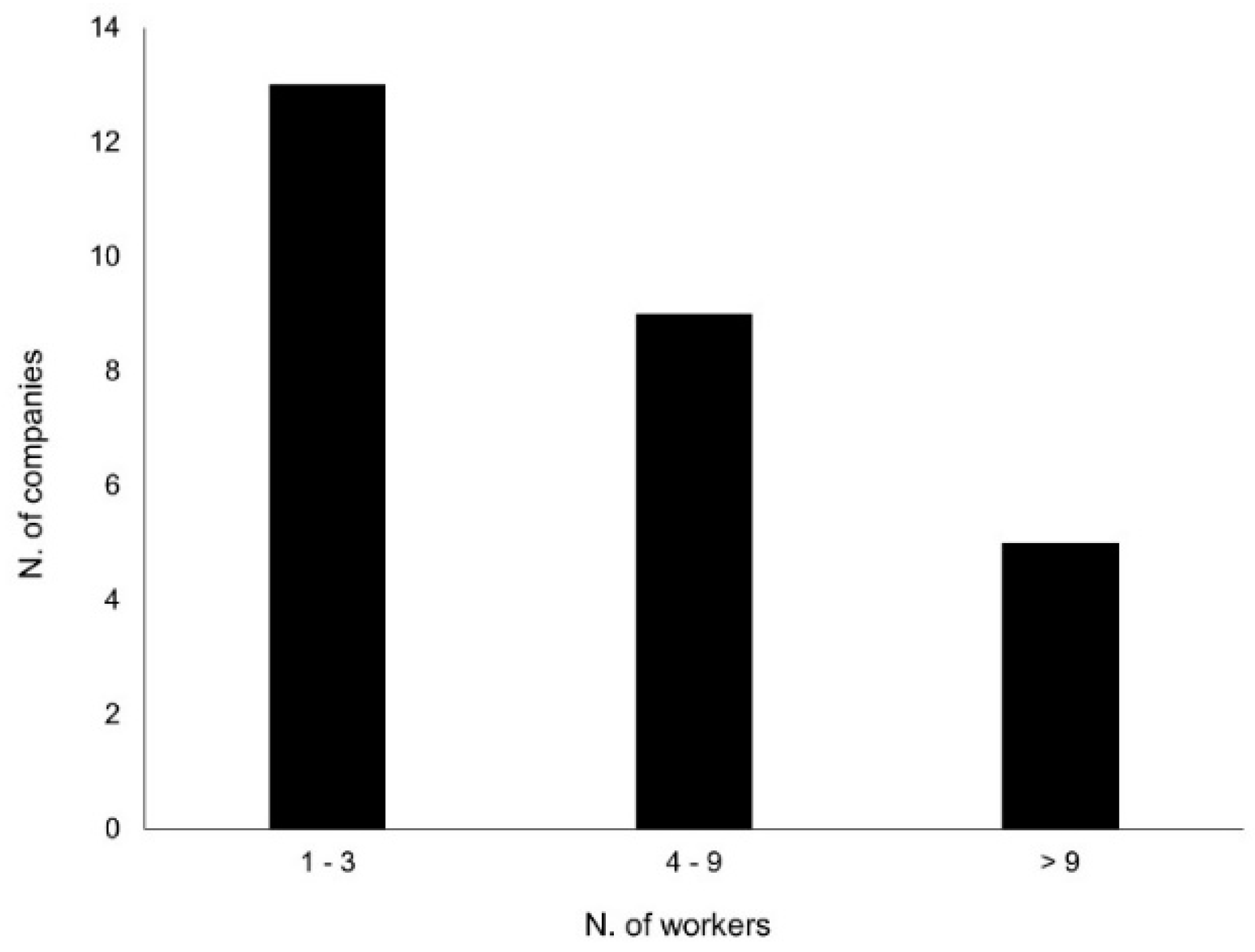
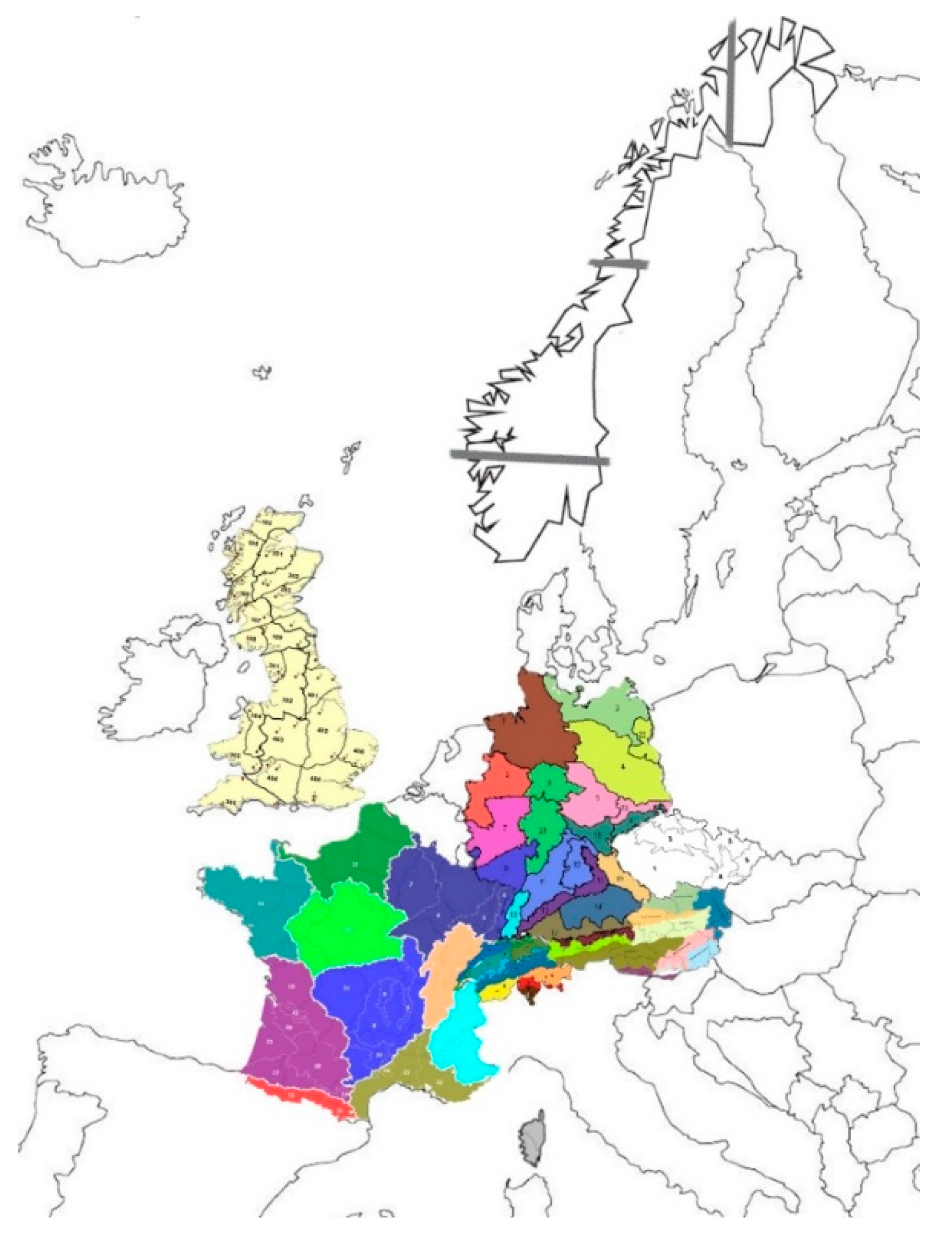
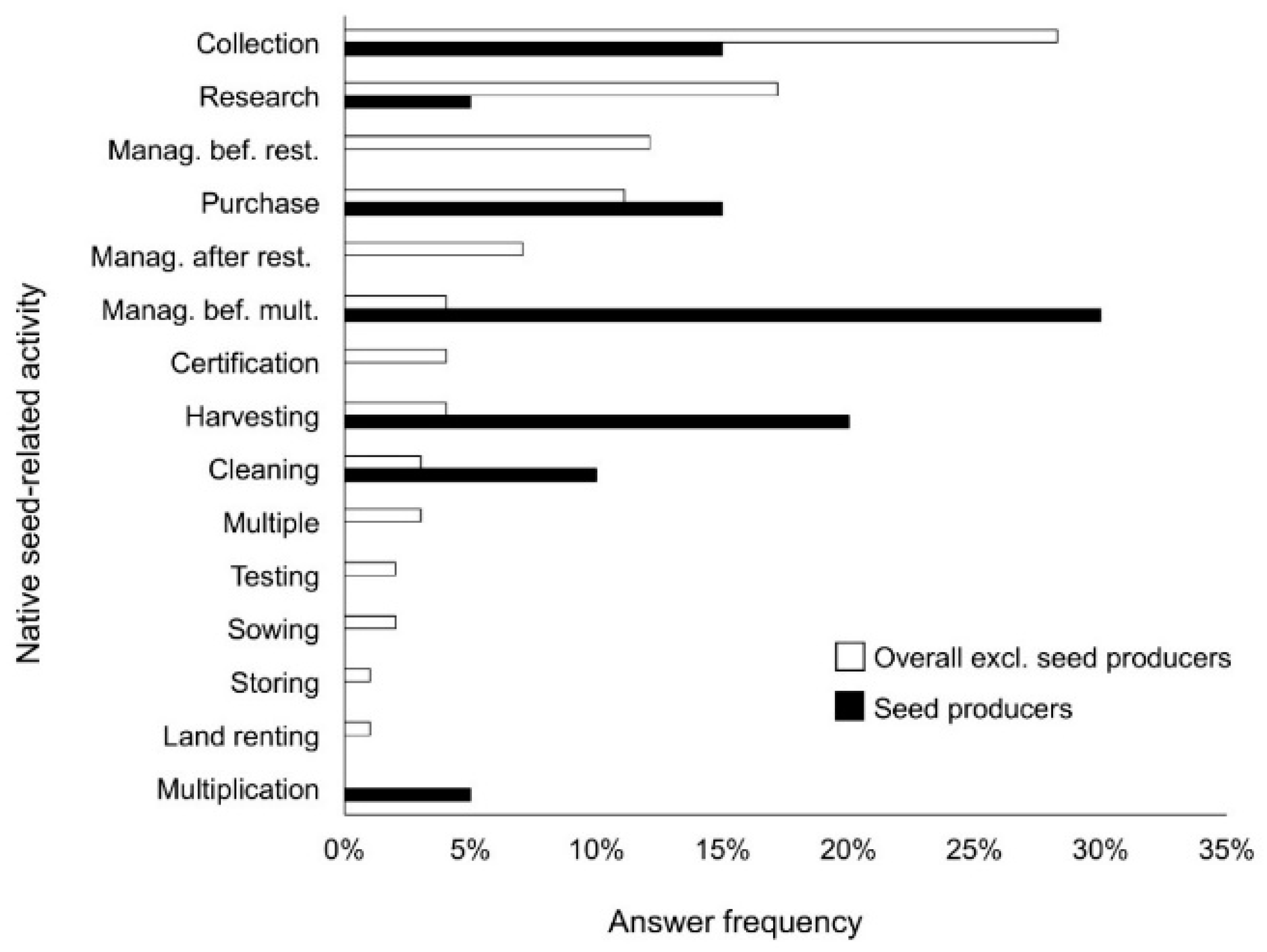
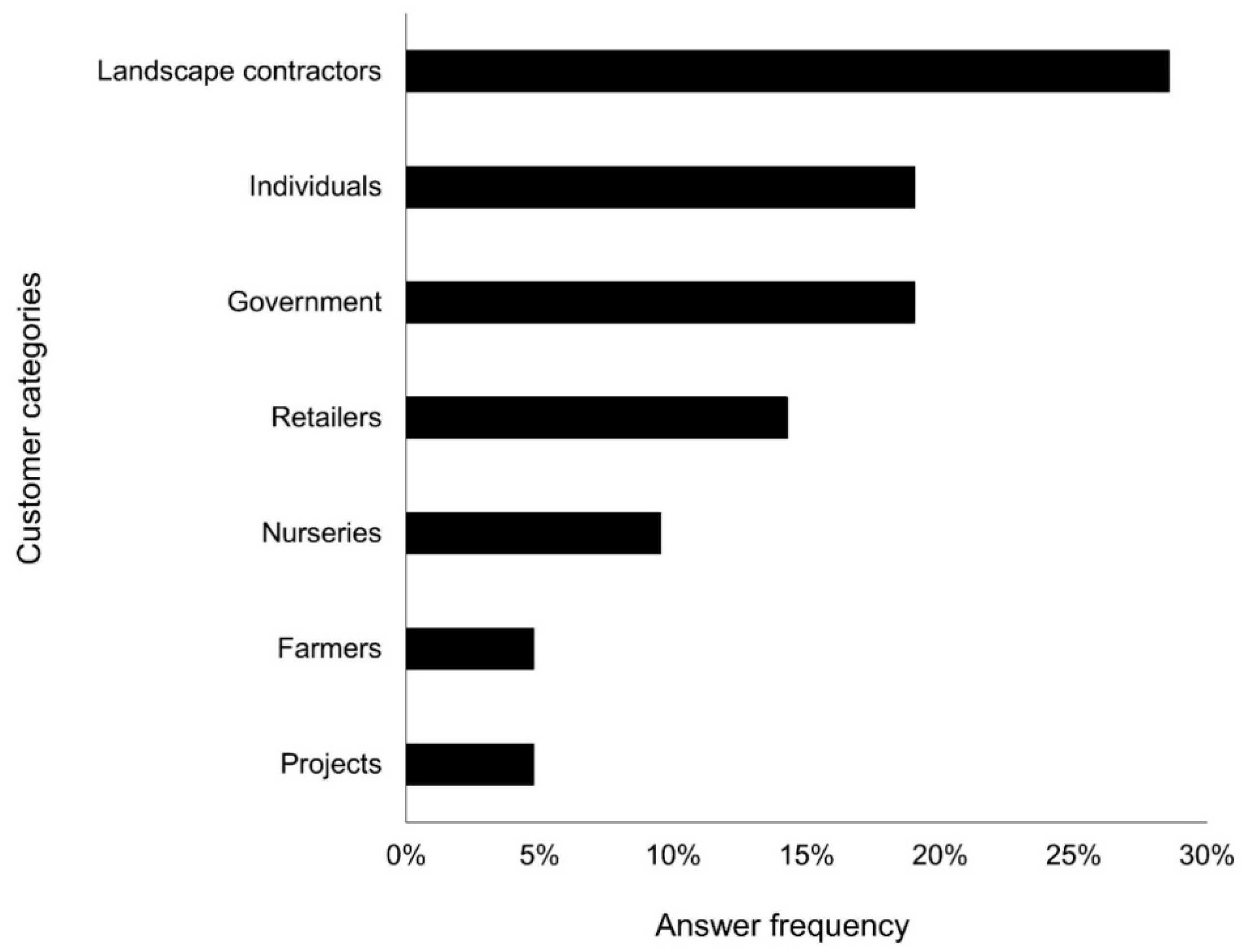
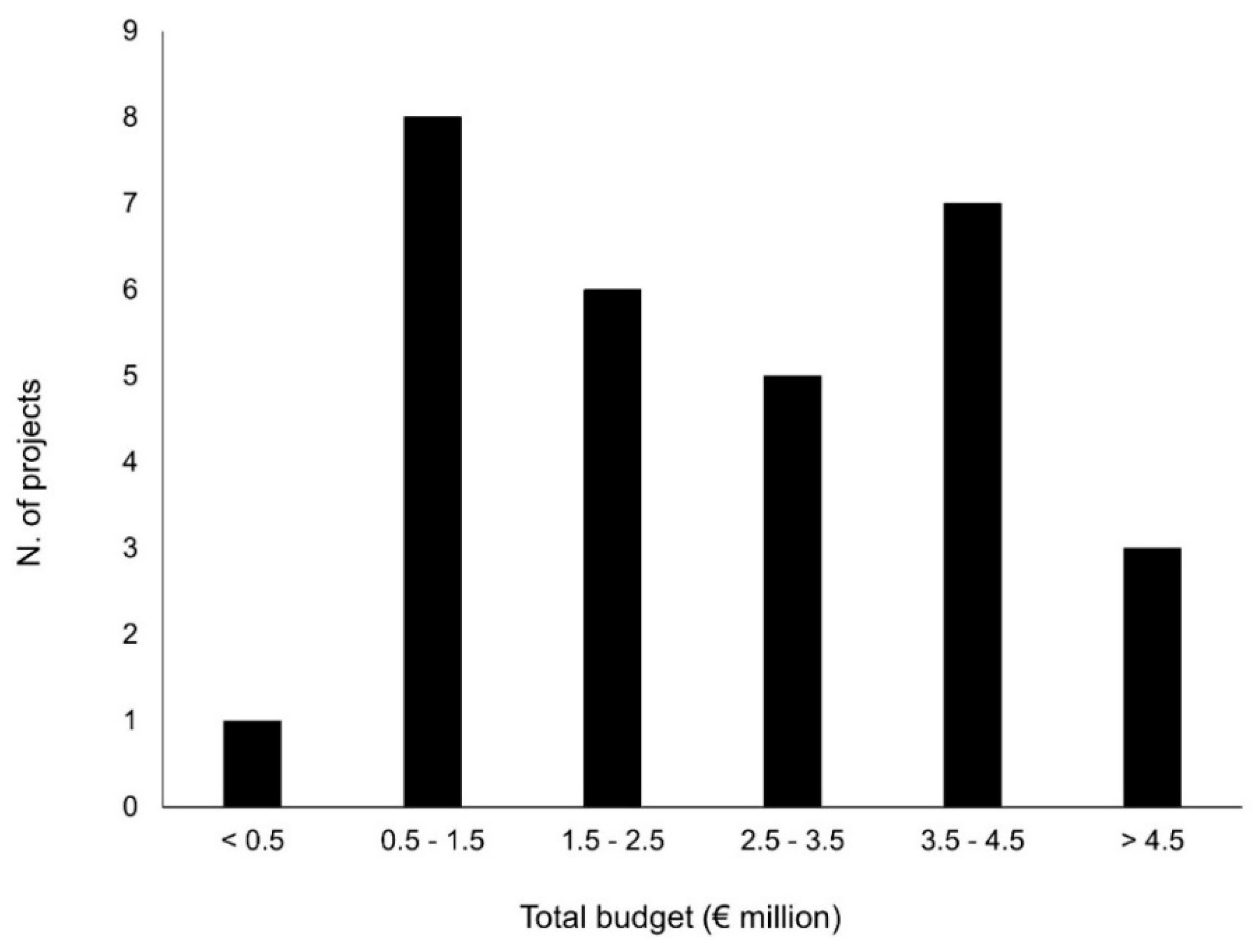
| Questions | n | |
|---|---|---|
| Question 1 | Which sector are you working in? | 215 |
| Question 2 | Which of the following best describes your current profession? | 215 |
| Question 3 | In which country is your profession or your main affiliation based? | 216 |
| Question 4 | Which species do you work with? | 188 |
| Question 5 | Do you use native seeds for your work? | 174 |
| Question 6 | On average, approximately how much do you spend on purchasing native seeds each year? | 77 |
| Question 7 | Which amount of native seeds do you buy or sell per year? | 83 |
| Question 8 | Which action related to native seeds or restoration is the most expensive for you? | 119 |
| Question 9 | Which category do your major customers belong to? | 81 |
| Question 10 | Is the demand for native plant material over the last 10 years increasing, stable or decreasing? | 136 |
| Question 11 | Are you in favor of the development of seed zones? | 123 |
| Question 12 | If a standard method is used, should seed zones cross country boundaries? | 122 |
| Question 13 | Do you use external protocols/guidelines for any of the following activities such as seed collection, cleaning, storage and treatment? | 99 |
| Question 14 | If yes, do you modify these protocols/guidelines to fit native seed requirements? | 48 |
| Question 15 | Do you have an active dialogue/collaboration with any academic/research institutes? | 112 |
| Question 16 | If no, would you like to have the scientific support of an academic/research institute? | 22 |
| Question 17 | If a trade association of native seed producers existed both at the European and national level, which one would you join? | 114 |
| Question 18 | Would you like to join a European online network to find other people who use native seeds to share material, knowledge and resources? | 113 |
| Question 19 | Are you involved in outreach activities aimed to promote the use of native plant material? | 115 |
| Country | Native Seed Producers | SZ 2 | |||
|---|---|---|---|---|---|
| NGO | Private | Public | Total | ||
| Austria | 1 | 9 | 10 | 10 | |
| Belgium | 3 | 3 | |||
| Bulgaria | 2 | 2 | |||
| Czech Republic | 3 | 3 | 5 | ||
| Denmark | 2 | 2 | |||
| France | 6 | 6 | 11 | ||
| Germany | 12 | 12 | 22 | ||
| Greece | 1 | 1 | |||
| Hungary | 2 | 2 | |||
| Iceland | 1 | 1 | |||
| Italy | 4 | 1 | 5 | ||
| The Netherlands | 4 | 4 | |||
| Norway | 2 | 1 | 3 | 4 | |
| Poland | 2 | 2 | |||
| Portugal | 2 | 1 | 3 | ||
| Republic of Ireland | 2 | 2 | |||
| Romania | 2 | 2 | |||
| Spain | 10 | 10 | |||
| Sweden | 3 | 3 | |||
| Switzerland | 12 | 12 | 11 | ||
| UK | 1 | 11 | 12 | 24 | |
| Tot. | 2 | 93 | 5 | 100 | |
| Range | Mid-Range | Frequency |
|---|---|---|
| Expenditure (€) | ||
| 1–100 | 50.5 | 26 |
| 101–5000 | 2550.5 | 26 |
| 5001–10,000 | 7500.5 | 7 |
| 10,001–100,000 | 55,000.5 | 17 |
| 100,001–500,000 | 300,000.5 | 1 |
| >500,000 | 500,000 1 | 0 |
| Total | 77 | |
| Mean | 17,599.2 | |
| Traded quantity (kg) | ||
| 0.01–0.1 | 0.055 | 8 |
| 0.2–1 | 0.6 | 11 |
| 2–10 | 6 | 21 |
| 11–100 | 55.5 | 12 |
| 101–500 | 300.5 | 6 |
| 501–1000 | 750.5 | 8 |
| 1001–10,000 | 5500.5 | 13 |
| 10,001–100,000 | 55,000.5 | 4 |
| >100,000 | 100,000 1 | 0 |
| Total | 83 | |
| Mean | 3615.8 | |
© 2017 by the authors. Licensee MDPI, Basel, Switzerland. This article is an open access article distributed under the terms and conditions of the Creative Commons Attribution (CC BY) license (http://creativecommons.org/licenses/by/4.0/).
Share and Cite
De Vitis, M.; Abbandonato, H.; Dixon, K.W.; Laverack, G.; Bonomi, C.; Pedrini, S. The European Native Seed Industry: Characterization and Perspectives in Grassland Restoration. Sustainability 2017, 9, 1682. https://doi.org/10.3390/su9101682
De Vitis M, Abbandonato H, Dixon KW, Laverack G, Bonomi C, Pedrini S. The European Native Seed Industry: Characterization and Perspectives in Grassland Restoration. Sustainability. 2017; 9(10):1682. https://doi.org/10.3390/su9101682
Chicago/Turabian StyleDe Vitis, Marcello, Holly Abbandonato, Kingsley W. Dixon, Giles Laverack, Costantino Bonomi, and Simone Pedrini. 2017. "The European Native Seed Industry: Characterization and Perspectives in Grassland Restoration" Sustainability 9, no. 10: 1682. https://doi.org/10.3390/su9101682





